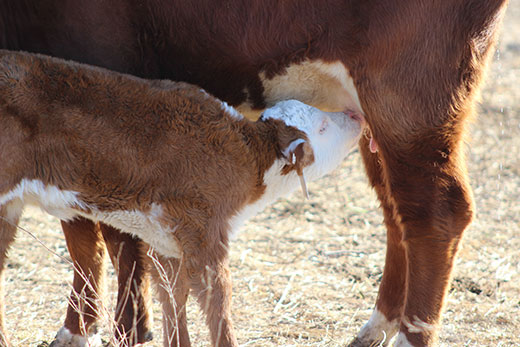
Calves need to nurse their mothers soon after they are born to maximize the immunity passed along in that first milk. | Download this photo.
K-State: First milk important to successful calving experience
Beef Cattle Institute experts offer advice on post-calving intervention
January 22, 2020
MANHATTAN, Kan. – Once the calves are born into a beef cattle herd, there is no better sight than watching them get up and begin to nurse their mamas.
However, experts in Kansas State University’s Beef Cattle Institute (BCI) say that difficult deliveries, inexperienced dams and calves born without vigor sometimes keep that connection from happening. It is at those times when a beef producer may have to intervene.
Trying to determine when to offer assistance to the cow/calf pair was a discussion topic among BCI experts during a recent podcast, available online. The chief concern is getting the colostrum into the calf within the first few hours after it is born.
“Colostrum is the first milk that the calf gets from its mother that contains a lot of immunity to set it up for the first four to five months of life,” said Brad White, veterinarian and BCI director. “As soon as the calf starts drinking, it has 12-24 hours to absorb the colostrum before his gut closes.”
As to when to intervene, the experts had a difference of opinion. “If I don’t observe a first calf heifer allowing her calf to nurse in the first two to four hours, I will get involved by helping,” said Bob Weaber, beef cattle extension specialist and BCI expert.
He added: “My goal is to get at least one quart of colostrum into the calf. After milking out the cow, I offer it to the calf through a bottle and if that doesn’t work, I use an esophageal tube feeder to deliver it.”
White prefers to follow a less aggressive approach by observing calf behavior over the course of 24-48 hours. “I am not going to intervene until the calf tells me it is not thriving, by walking with its head down or trying to nurse off of other cows,” he said.
He added that if he does intervene, his goal is to gather the milk from the calf’s dam rather than using colostrum supplementation. White said the immunity in the colostrum comes from the proteins in the dam’s milk and that milk from beef cows is more nutrient dense than that of dairy cows (which is what most colostrum supplements consist of). So, with supplementation of dairy colostrum, White said the supplementation goal is to provide two quarts.
Both experts agree that the quantity and quality of the colostrum produced by the cow has a direct correlation to the dam’s body condition score.
“A cow in good body condition will have the nutrition she needs to make the proteins to pass on the immunity to her calf,” White said.
He also stressed the importance of calving in a dry, clean environment.
“The immunity is only as effective as the challenges we put it under, so if the calf is born in a mud lot, the cow’s udder may be covered in mud and that will give the calf a high pathogen challenge when it tries to nurse,” White said.
If supplementation is ultimately necessary, White and Weaber agreed that getting the milk delivered to the calf at the correct temperature is critical.
The goal is feeding it at a temperature of 100 degrees, Weaber said. White adds: “It is best to warm up the milk in a hot water bath. If you microwave it, you will destroy a lot of those proteins.”
White and Weaber offer these five tips:
- Maintain cows in good body condition to maximize the quality and quantity of the colostrum they produce
- Develop herd immunity by following a vaccination schedule
- Ensure cows have a dry location in which to calve
- Have an intervention plan in place for colostrum supplementation
- Keep intervention equipment such as a bottle or esophageal tube feeder on hand
More information on this topic is available on a weekly podcast produced by the Beef Cattle Institute.

